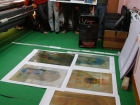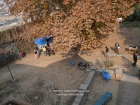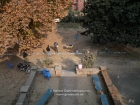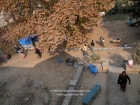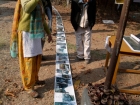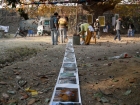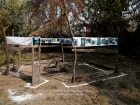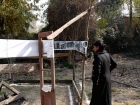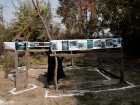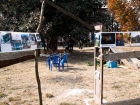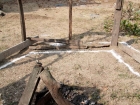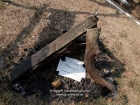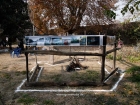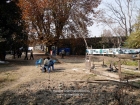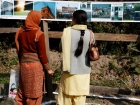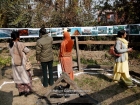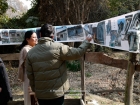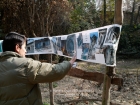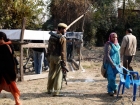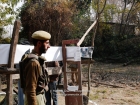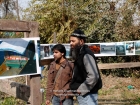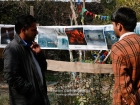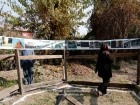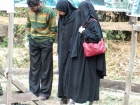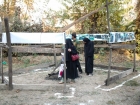Installation ‚Fragile Hope – Bridging the Gap‘
I. Glimpses of the installation on the Open Day
II. The photographs of Installation ‚Fragile Hope – Bridging the Gap‘
III. Depiction of the installation ‚Fragile Hope – Bridging the Gap‘
I. Glimpses of the installation on the Open Day
II. The photographs of Installation ‚Fragile Hope – Bridging the Gap‘
coming soon
III. Depiction of the installation ‚Fragile Hope – Bridging the Gap‘
Fragile Hope – Bridging the Gap by Herbert Grammatikopoulos
My photographic work in general is found on the idea, to capture a precise moment and to tell at least an essential part of a story witch one good photograph, which touches you, your heart, your mind, your soul. Sometimes it’s the play of the light with shadow, sometimes the pose of the people, sometimes the curiosity, sometimes it’s just beauty.
What is photography? On of the worlds most famous photographers once said: its the capture of a moment. the uniting (merger) of mind, eye and heart in the same axis (as Henri Cartier-Bresson once said).
Most of my installations and photography work is connected to my very main topic „peace“. I give documentary subjects, like freedom of mind, health, democracy, human rights, social exclusion/inclusion etc. priority. My work is more minimalistic, as well by the result you can see as by equipment: I use only one camera and one lens, nothing else, even no tripod, filters. When I go for a shooting, I try to keep my eyes open and not being fixed by a idea I had before. I love to do snap decisions, being spontaneous. I love to make you look for details you may see every day, but never recognize, because it’s part of your daily life, but for me as a stranger it’s at least curious.
In my installations, as well in my photographs, I try to mix medias and to work with other artist from different fields – like painters, poets, musicians and dancers.
When I first saw the destructions and demolitions in Srinagar with my own eyes, I had the idea to transform my feelings and shock into an, on the first sight very simple symbol of day to day life, with a sad and at the same time hopeful aspect.
I decided to built a symbolic house, gone to ruin and to decorate it with a ribbon, as a symbol of solidarity, with the prints of more than hundred photographs I took in the first week of my stay, forming a kind of fairy tail story from riots and suppression, to a new beginning.
With a minimum use of a few wooden boards I found on the compound, I started to build the imaginary ruined round house around an open fireplace in the garden, about the size of a living room. In the centre was some of the burnt wood from the days before, when the artist group had a little gathering, with three small pillars, forming a little pyramid, symbolising the rest of a roof. This „house“ has an open door, where the spectators first could go in to watch and read the fairy tail story, while walking clockwise along the imaginary walls. On the floor was a kind of path made of white powder where the people could walk on. This path leads the people to follow the story also on the outer wall anticlockwise until they will reach at the end of the fairy ail the door again for a third time.
To walk inside and outside the house is a symbol of inner and outer view on one and the same subject, as well as to go in and out a door, from public open to private inner space, using a door as a border in between.
When entering the inner circle, you have to walk clockwise, f.e. like a Buddhist will make his round at a stupa, while the outer circle will lead you counter clockwise, like in other religions.
I wanted to express with this, that there are always at least two points of view on something, and when reaching the door at the end a third time, there maybe will be a third point of view, like a coin has not only two faces, but a third, its thickness . The door is always open to see and change one’s before fixed opinion on something.
Some Cogitations
When I was invited by KHOJ to this event, I was not really scared about coming (again) into a country which is under occupation and in permanent unrest. I’ve been much more happy to got the opportunity to do a workshop with local and international artists from around the globe in Kashmir, even under this particular circumstances, is a big opportunity to learn, exchange and to understand. As an ethnologist and photographer I’m very interested in any culture.
I never been to India before, even I have just lived more than three years in Nepal before.
At first, when arriving, from a foreigners view on the surface, Kashmir looks quit ‘normal’, mixed with something what we call exotic, what means just strange, unease and incomprehensible. But this slight impression turned very fast as deeper as I got involved.
Once, Kashmir was home of diverse ideas and philosophies, but now I could get only a little glimpse of this. Almost everything connected to this past era seemed to be covered by the obviously visible leftovers of riots and militant quarrels, the barbed wires, bunkers, soldiers everywhere.
This leads to a lack of cultural identity, visible in the virtually negligence of the symbols of the own culture, like architecture, the destruction of the traditional houses, historic buildings, but also in the field of traditional arts and crafts, displaced by the so called achievements of modern times and globalization.
The overall situation in Kashmir itself was not as worse as expected, but still tense and far away from so called ‘normality’. But the more you see, the more you perceive. First it don’t looks so violent. For me, Kashmir has many aspects comparable with Nepal, like civil war situation, poverty (besides cultural conformities in style and nature). In Nepal there had been almost every day violent demonstrations, riots and fights. One learn fast, to be on alert the whole day. In comparison to this, it seems that Kashmir is in this moment almost ‘peaceful’, but appearances are strongly deceptive. The dominant presence of armed police demonstrates that there must be a huge potential of dissatisfaction, which is obviously suppresed, very controlled and so a relatively so called ‘safe’ situation.
After the workshop, I had the opportunity to stay a week longer with some of the Khoj Kasheer group, which was again a great experience for me. So I could get much closer to the specifics of Kashmiri culture and daily life, understanding more of the transformation of a cultural scene over the decades.
I just hope for the sake of the people that it will not explode again in the way it happened several times in the past. Again these will be only pain and mourning, only losers and (innocent) victims, and again it will not bring any positive changes or development or results, as you easily can see when you compare similar situations around the globe.
A much more difficult road has to be gone by each and everyone in Kashmir, in India and as well in Pakistan. There is no way than respect, tolerance and understanding. There is no solution without peace. Peace under any conditions.

